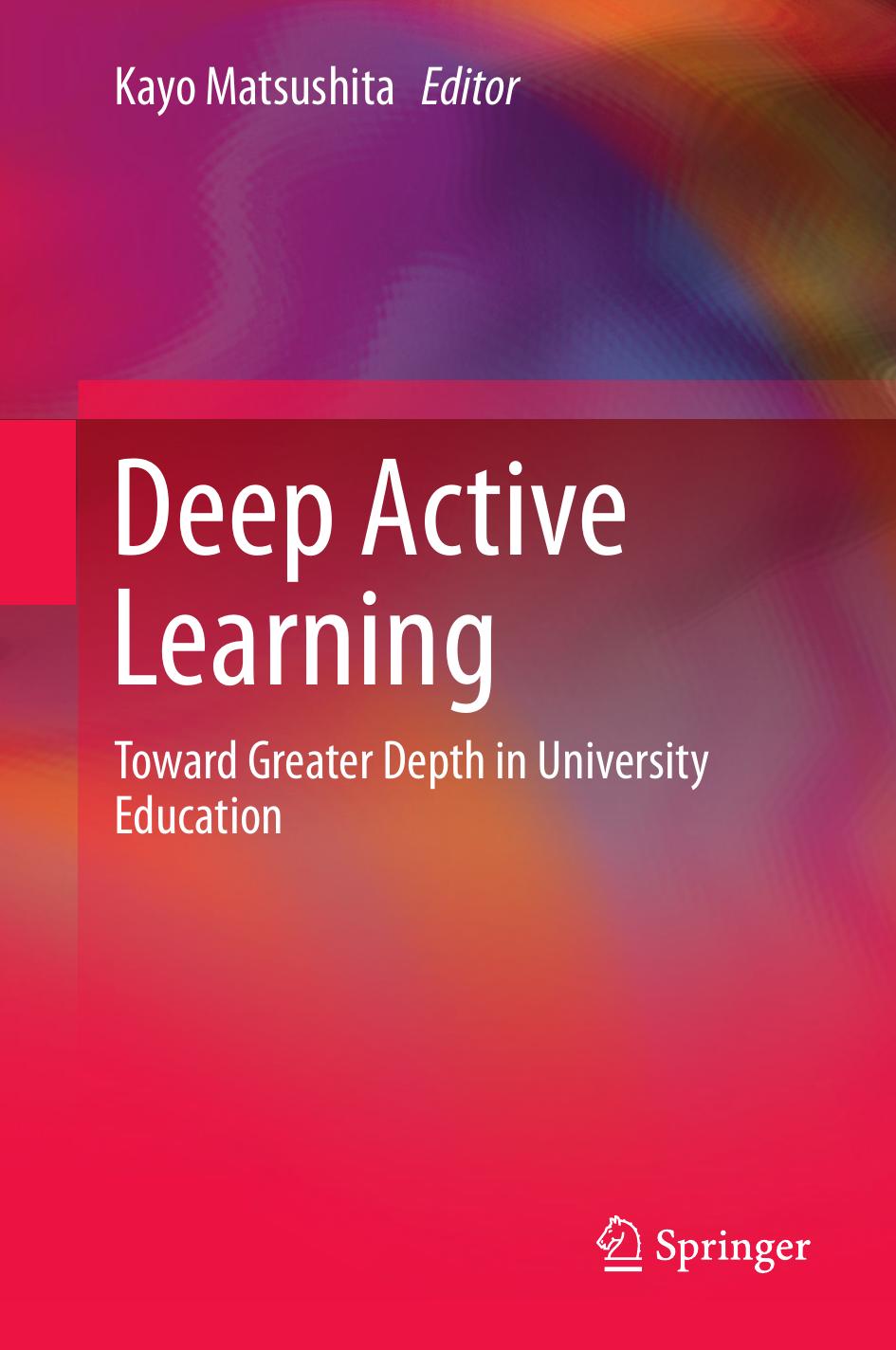Deep Active Learning Toward Greater Depth in University Education 1st edition by Kayo Matsushita ISBN 9811354561 978-9811354564
$70.00 Original price was: $70.00.$35.00Current price is: $35.00.
Instant download Deep Active Learning Toward Greater Depth in University Education 0002624 after payment
Deep Active Learning Toward Greater Depth in University Education 1st edition by Kayo Matsushita – Ebook PDF Instant Download/Delivery: 9811354561, 978-9811354564
Full download EDeep Active Learning Toward Greater Depth in University Education 1st edition after payment

Product details:
ISBN 10: 9811354561
ISBN 13: 978-9811354564
Author: Kayo Matsushita
This is the first book to connect the concepts of active learning and deep learning, and to delineate theory and practice through collaboration between scholars in higher education from three countries (Japan, the United States, and Sweden) as well as different subject areas (education, psychology, learning science, teacher training, dentistry, and business). It is only since the beginning of the twenty-first century that active learning has become key to the shift from teaching to learning in Japanese higher education. However, “active learning” in Japan, as in many other countries, is just an umbrella term for teaching methods that promote students’ active participation, such as group work, discussions, presentations, and so on. What is needed for students is not just active learning but deep active learning. Deep learning focuses on content and quality of learning whereas active learning, especially in Japan, focuses on methods of learning. Deep active learning is placed at the intersection of active learning and deep learning, referring to learning that engages students with the world as an object of learning while interacting with others, and helps the students connect what they are learning with their previous knowledge and experiences as well as their future lives. What curricula, pedagogies, assessments and learning environments facilitate such deep active learning? This book attempts to respond to that question by linking theory with practice.
Deep Active Learning Toward Greater Depth in University Education 1st Table of contents:
1 Introduction
Active Learning Boom in Japanese Education
The State of Higher Education in Japan
Changing University Entry Rate
Narrow Age Distribution of New Entrants
High Completion Rate
Expectations from University Graduates
The Context of Active Learning Dissemination
What Kind of Abilities Should Be Fostered at Universities?
In What Way Should Students Learn?
Our Book’s Conception and Its Influence in Japan
Introduction to the Chapters
References
The Theoretical Foundation of Deep Active Learning
2 An Invitation to Deep Active Learning
What Is Active Learning?
Problems with Active Learning
From Surveys and Case Studies
The Twin Sins
Discrepancies Between Knowledge (Content) and Activities
Passivity Induced by Classes that Aim at Active Learning
Diversity of Learning Styles
The Connection Between Knowledge and Activities
The Structure of Learning Activities
The Processes of Learning Activities
Internalization and Externalization
The Span of the Learning Cycle
The Lineages of Learning Theories Focusing on Depth
Deep Learning
A Deep Approach to Learning
The Effects of Teaching and Assessment
Objects of Learning and Variation Theory
Deep Understanding
Deep Engagement
The Meaning of Deep Active Learning
Summary
References
3 Terms of Engagement: Understanding and Promoting Student Engagement in Today’s College Classroom
Defining the Term “Student Engagement”
Towards a Classroom-Based Model for Understanding Student Engagement
Engagement and Motivation
Value
Expectancy
The Interaction of Value and Expectancy
Engagement and Active Learning
What We Know from Neuroscience
What We Know from Cognitive Psychology
The Role of Transfer in Active Learning
Similarity and Differences
Association
Context and Degree of Original Learning
The Role of Memory in Active Learning
Short and Long Term Memory
The Importance of Sense and Meaning to Long-Term Memory
Retention
Three Conditions that Promote Deep Engagement
Condition One: The Task Has to Be Appropriately Challenging
Condition Two: Sense of Community
Condition Three: Teach so that Students Can Learn Holistically
Conclusion
Summary
References
4 Towards a Pedagogical Theory of Learning
The Importance of Variation in the Object of Learning
Learning and Discernment
Variation and Simultaneity
The Object of Learning and the Space of Learning
What Is Critical for Students’ Learning?
Medical Education
Accountancy Education
Differences Between Conditions and Between Individuals
Making Learning Possible
The Variation Theory of Learning
Summary
Appendix: Reinterpreting Approaches to Learning
Deep and Varied Approach to Learning
Surface and Less Varied Approach to Learning
References
5 Deep Active Learning from the Perspective of Active Learning Theory
What Is Active Learning?
Definition
The Shift from Positioning A to Positioning B
Practical Suggestions to Enhance the Quality of AL-Based Instruction
Assessing Learning Hours Outside the Class
Backward Design
Curriculum Development
Multiple Classes Per Week
Building an Environment for Active Learning
Flipped Classroom
Why Is Deep Active Learning Indispensable?
Deep Approach to Learning
Not Learning Style But Approach to Learning
Summary
References
Attempts in Various Fields
6 The Flipped Classroom: An Instructional Framework for Promotion of Active Learning
What Is the Flipped Classroom?
What Is New About the Flipped Classroom?
The Flipped Classroom as a Type of Active Leaning
Design and Implementation of a Flipped Classroom
Knowledge Acquisition Model
Investigative Model
Avoiding the Gap Between Thought and Action (The Pathway Between Internalization and Externalization
Reconsidering Active Learning
Summary
References
7 Class Design Based on High Student Engagement Through Cooperation: Toward Classes that Bring About
Theory of Cooperative Learning
Diffusion of Cooperative Learning
Class Design Based on Spirit of Cooperation
Basic Elements of Cooperative Learning
Techniques of Cooperative Learning
Types of Techniques
Key Points for Implementing the Techniques
Teaching Skills Required of Instructors
Effects and Evaluation of Cooperative Learning
Expected Effects of Cooperative Learning
Evaluation in Cooperative Learning
Class Design Using the Learning Through Discussion Method
LTD Method
Problems and Objectives
Outline of the Class and Its Composition
Development of the Class
Reading Stage
Argumentation Stage
Composition Stage
Results of the Class
Discussion of Practical Implementation
Reliance on Cooperative Learning
Adoption of Segmented LTD
Conducting Classes Based on LTD
Aiming for Classes that Realize Deep and Tangible Change and Growth
Summary
Acknowledgements
References
8 Deep Learning Using Concept Maps: Experiment in an Introductory Philosophy Course
Background to This Case Study
Deep Learning and Concept Maps
Designing a Class that Uses Concept Maps
Outline of the Course
Class Plan
Significance of Concept Maps as a Learning Tool
Concept Maps as an Assessment Tool
Developing a Rubric for Assessing Concept Maps
Concept Map Review Session
Creating the Rubric
Assessment Using the Rubric
Effectiveness of Concept Maps as a Tool for Deep Active Learning
Summary
References
9 Course Design Fostering Significant Learning: Inducing Students to Engage in Coursework as Meaning
Practice: Initiatives to Methodologies of Teaching
Methodologies of Teaching, A Course in a Teacher Training Program
My Intentions (or Wishes)
Initiatives to Achieve the Goals
My Active Learning
Summary of the Section
Verification: Reviewing the Course
Method
Discussion
Responsibility for Learning
Motivation for Learning
Reflection for Learning
Summary of the Section
Conclusion
Summary
Appendix 9.1: Course Syllabus
Appendix 9.2: Dialogue Journal
Appendix 9.3: Example of Preparation Mindmap
Appendix 9.4: Manabi-Hajime Sheet
Appendix 9.5: Direction for Preparing a Reflection Paper
References
10 PBL Tutorial Linking Classroom to Practice: Focusing on Assessment as Learning
Two PBLs
PBL in Practice
PBL and the Curriculum
Scenario Design
Facilitator Development
How Students View PBL
Assessment of PBL Learning Outcomes
The Ability Assessment Issue
Development of the ‘Modified Triple Jump’
Introduction of the Modified Triple Jump into the Curriculum
Learning Effects of the Modified Triple Jump
Toward Deep Active Learning
Summary
References
11 New Leadership Education and Deep Active Learning
What Is New Leadership?
Emergent Leadership
Too Many Cooks…
Leadership Without Authority
The Three Minimum Elements of Leadership
New Leadership Education Generates Active Learning in a Broad Sense
Deep Learning Can Happen During the New Leadership Education Course
Linkage with Other Courses
Significance as Career Education
Linkage with Sports and Music Activities
Active Learning Is Based on the New Leadership by Students
Support for Active Learning as Leadership Education: An Alternative Definition of Active Learning
The “Training Wheels” Metaphor: Meaning of Deep Learning
Quiet People and Active Learning
Summary
Acknowledgements
References
Author Index
Subject Index
People also search for Deep Active Learning Toward Greater Depth in University Education 1st :
deep active learning toward greater depth in university education
depth of knowledge explained
deep level of learning
deep active learning with adaptive acquisition
deep learning active learning
Tags: Kayo Matsushita, Deep Active, Toward Greater, University Education


